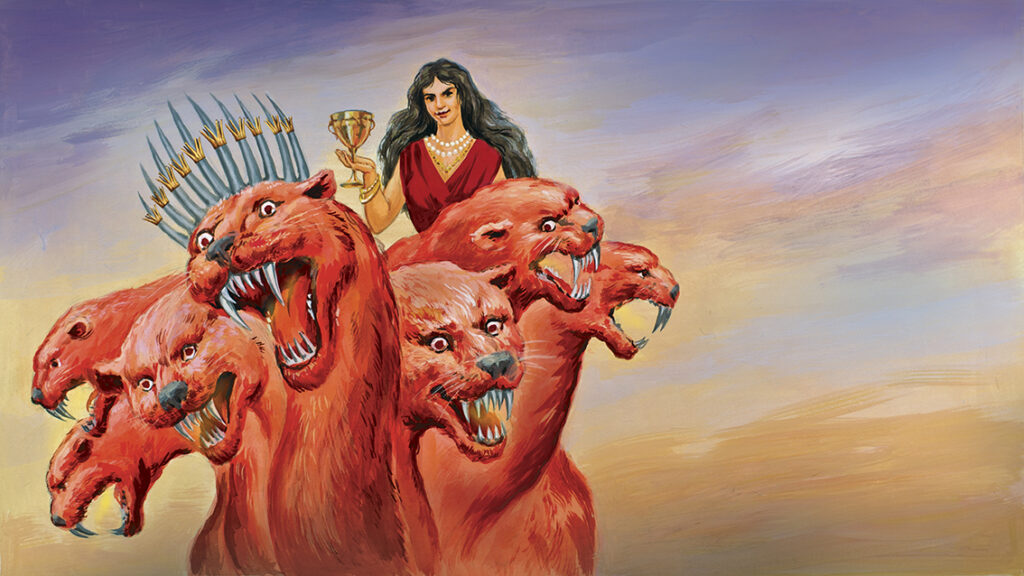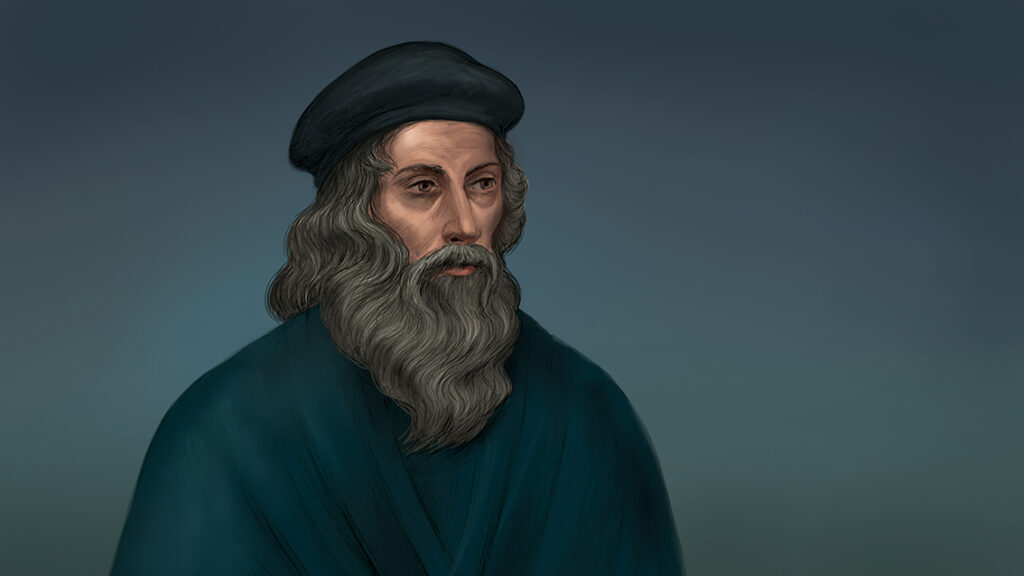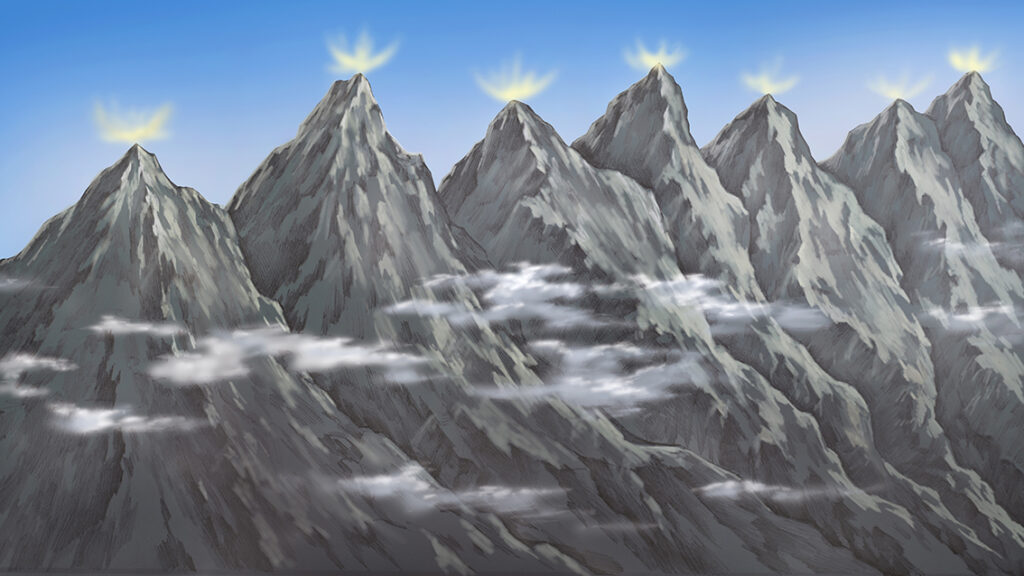
31. The Great Harlot
In Revelation 17, we meet the great harlot, the most obvious portrayal of the Catholic Church. The angel who guided John said, “Come and I will show you the judgment of the great harlot who sits on many waters.”Rev 17:1 By the late 15th century, European missionaries and explorers had spread their teachings to the Americas, Asia, Africa, and Oceania. The angel described the harlot:
“With whom the kings of the earth committed fornication”Rev 17:2 — The Church compromised its teachings to appease those with political power.
“All those who dwell on the earth are made drunk with her immorality”Rev 17:2 — Isaiah called them “the drunkards of Ephraim.”Isa 28:1
Come and I will show you the judgment of the great harlot who sits on many waters.
Revelation 17:1
John described the harlot, he saw:
Sitting on a scarlet beastRev 17:3— In the Basilica of St. Paul, there are the portraits of 109 popes, all in scarlet.
Full of blasphemous names, having seven heads and ten hornsRev 17:3 — This was the same beast described in Revelation 13.
Clothed in purple and scarletRev 17:4 — The bishops wore purple, and the cardinals and the pope wore scarlet.
Adorned with gold and precious stones and pearlsRev 17:4 — The churches were adorned with precious stones and had magnificent architecture.
Having in her hand a golden cupRev 17:4 — Jeremiah wrote, “Babylon was a golden cup in the Lord’s hand, that made all the earth drunk.”Jer 51:7
Full of abominationsRev 17:4 — The apostle Paul said, “Whosoever eats the bread or drinks the cup of the Lord in an unworthy manner shall be guilty of the body and the blood of the Lord.”1 Cor 11:27
On her forehead was the name—Mystery BabylonRev 17:5 — This was the spiritual kingdom of those who worshiped the beast.
The mother of harlots and of the abominations of the earthRev 17:5 — She was the mother of denominations that mixed pagan religious practices with Christianity.
And I saw the woman drunk with the blood of the saintsRev 17:6 — The Church was responsible for the death of thousands of saints.

32. John Sees a Great Harlot in the Wilderness
John said he was “carried by the Spirit into a wilderness”Rev 17:3 to see a woman who was sitting on a scarlet beast. The wilderness was the place of the saints who flew into the wilderness for “a time, times, and half a time,” away from the serpent.
The Dark Ages, the 5th–10th centuries, were called such because the Church used political power to enforce its doctrines.
After the East–West Schism and the advent of Hildebrand, the power of the popes increased significantly, and they became increasingly corrupt. Most were murderers and extortionists. They burned heretics at the stake and sold the forgiveness of sins in indulgences. Many of them had a reputation for their love of money and for fathering illegitimate children.
In his Historical Studies, Eugene Lawrence wrote, “From the twelfth to the fifteenth century the people of Europe were nearly united in opposition to the Roman See…. Every country in Europe swelled with dissidents who repelled as the Antichrist the bishop of Rome.”1
And he carried me away in spirit into the wilderness and I saw a woman sitting on a scarlet beast
Revelation 17:3
In the 12th century, Peter Waldo became the first person to translate the Bible into the common language. From him came the sect of the Waldenses. Dissident groups like the Waldenses opposed the practices of the Church but remained under its power.
John Wycliffe, who died in 1384, translated the Bible into English and preached that the Bible should be the only authority of the faith. He said that the pope was the Antichrist and that the claims of the papacy were unhistorical. He also claimed that the moral depravity of priests invalidated their sacraments.
John Wycliffe’s preaching found its way to Jan Huss in Bohemia. Jan Huss preached against indulgences more than 100 years before Martin Luther did. In 1415, Jan Huss was burned at the stake. After this, the Bohemian Archbishop Jan Rokycana preached that the Church of Rome was Babylon and that the pope was the Antichrist.
33. The Seven Heads and Ten Horns Explained
In Revelation 13, the diadems on the seven heads of the dragon moved to the ten horns, the ten states of Europe. The seven heads and ten horns of this beast are best understood in Revelation 17.
“The beast that you saw was and is not.”Rev 17:8 — The beast was established by “the lie” of Satan. It “was and is not.”
“Is about to come up out of the abyss.”Rev 17:8 — The same description of the beast can be found in Revelation 11. It is the beast that will kill the two witnesses.
“All those who dwell on the Earth whose names have not been written in the book of life from the foundation of the world will wonder when they see the beast.”Rev 17:8 — The people of the world are misled by this beast in a drunken state.
And there are seven kings, five have fallen, one is, and one is to come
Revelation 17:10
“Here is the mind that has wisdom — the seven heads are the seven mountains on which the woman sits.”Rev 17:9 —Here, the Protestant Reformers looked to Rome because Rome was on seven hills, but the next phrase was incorrectly copied in later manuscripts, saying, “There are seven kings.”
The earliest manuscripts said:
“They are seven kings.”Rev 17:10 — The seven mountains are seven kings.
“Five have fallen.”Rev 17:10 — Looking backwards from John’s time, there were five kingdoms that kept the saints in captivity: Greece, Persia, Babylon, Assyria, and Egypt.
“One is….”Rev 17:10 — This is Rome.
“The other is yet to come.”Rev 17:10 — This is described in verse 12 as “ten kings who have not yet received a kingdom.” The seventh head is a conglomeration of the ten kings.
“He must remain a little while.”Rev 17:10 — The conglomeration of the ten kingdoms will remain a little while, but the kingdom of the beast will continue.
“The beast is also … eighth.”Rev 17:11 — The Greek lacks the article for “eighth” because the kingdom of the beast was not consecutive to the seventh kingdom. It began in the days of the seventh kingdom.
“And is one of the seven….”Rev 17:11 — The beast was identified by the name Lateinos, the Latins, who were among the seven.


- Historical Studies, Eugene Lawrence, 1876, pp. 202. ↩︎
